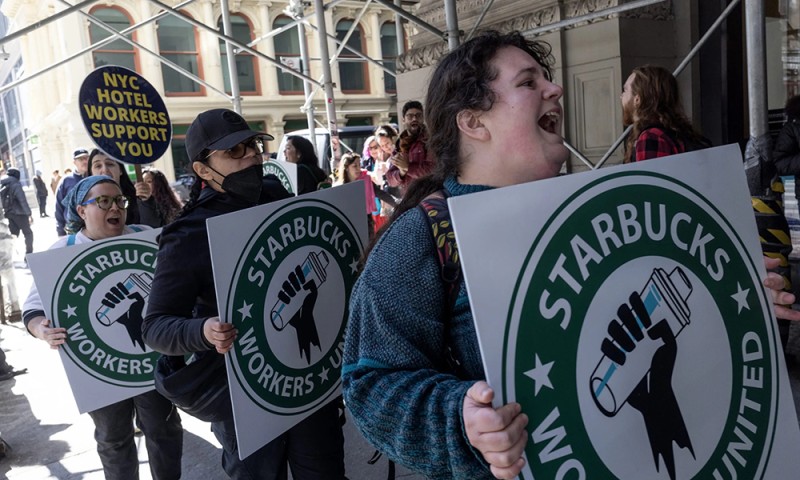
• 若能有效达成“回归星巴克”转型战略中的成本节约和及时推广目标,星巴克将向高管发放最高达600万美元的股票奖励。在围绕咖啡师薪资的合同谈判期间,星巴克工人联合会代表称此举“荒谬且不负责任”。
尽管员工对星巴克给予咖啡师的薪资待遇发起抗议,但星巴克仍在加大对高管的激励力度,以期加速公司扭亏为盈的进程。
根据上周三提交的文件,若高管能迅速达成成本节约目标,这家咖啡连锁企业将向他们发放最高达600万美元的股票奖励。这一纯粹以业绩为导向的激励举措,旨在推进新任首席执行官倪睿安(Brian Niccol)提出的“回归星巴克”计划——该计划旨在让星巴克回归昔日那种温馨舒适的“第三空间”定位。
文件中提到:“这些奖励旨在激励并留住高级管理层,以实现扭亏为盈计划所要求的重大变革。奖励与‘回归星巴克’计划关键环节的完成情况直接挂钩,以此鼓励高级管理层尽快达成相关目标。”
文件显示,这些目标包括推广星巴克的“绿围裙服务”计划(该计划利用技术加快订单处理速度)、“新食品和饮料平台”以及“重新设计的星巴克会员奖励计划”。员工有资格在星巴克2027财年结束时(即2027年9月)获得股票奖励。
员工最高可获得目标金额200%的奖励,但必须在基于业绩的限制性股票单位归属日前持续在岗。
自2024年9月就任星巴克首席执行官以来,倪睿安对这家总部位于西雅图的咖啡连锁企业实施了全面改革,包括为咖啡师制定绿围裙着装规范、引入手写订单名称等人性化举措,以及重新设计招聘流程以充实门店员工队伍。在销售业绩下滑的背景下,这位首席执行官期望星巴克恢复昔日声誉——彼时顾客会在舒适的店内座椅上悠然享用拿铁。
倪睿安在担任首席执行官的第一年有望获得高达1.13亿美元的收入,其中包括160万美元的基本薪资、7500万美元的股权奖励,以及因在前六个月留任而获得的1000万美元签约奖金。
咖啡师对薪资的不满
与高管层不同,星巴克柜台后的员工正奋力争取时薪的稳步增长。彭博社12月援引一份内部文件报道,2024年咖啡师的薪资涨幅较小,约为2%至3%,而此前数年的涨幅为3%至5%。此次工资涨幅放缓与绩效无关,正值该年星巴克面临挑战——在遭遇抵制活动、服务速度放缓后,门店客流量和销售额均有所下降。这家咖啡连锁店向咖啡师支付的平均时薪为19美元,加上福利后总计约为30美元。
加入工会的星巴克咖啡师在与管理层协商新合同的过程中,对薪资提出异议。双方的谈判已持续两年,今年4月,星巴克工人联合会拒绝了公司提出的每年至少加薪2%的提议。星巴克未回应《财富》杂志的置评请求。
星巴克上周三披露的高管奖金等情况,成为员工的又一不满之处,尤其是在合同谈判期间。纽约州布法罗市的咖啡师、星巴克工人联合会的谈判代表贾思敏·莱利(Jasmine Leli)对《财富》杂志表示,给高管发放600万美元奖励足以体现星巴克“荒谬且不负责任”。
莱利在一份声明中表示:“星巴克不能一方面声称资金短缺,无法为咖啡师提供公平合理的工会合同,另一方面却在2024年为倪睿安120天的工作支付高达9600万美元,还为经理们举办奢华的会议,并为高管发放数百万美元奖金。‘回归星巴克’计划只有在咖啡师能够获得良好发展机遇时才能成功——而第一步便是敲定一份公平的工会合同,明确我们工作所需的人员配置、工作时长和保障措施。”
从更宏观的层面来看,并非所有咖啡师都认同公司的“回归星巴克”战略。今年5月,美国120家门店的2000多名星巴克咖啡师举行罢工,称新着装规范并非提升客户体验的有效举措。
星巴克当时在一份声明中表示:“如果工会能拿出抗议穿黑衬衫上班的那份劲头回到谈判桌前,那会更有成效。”
其他员工则提议为门店提供更为便捷的方式暂停线上订单,以缓解咖啡师的工作压力。莱利指出,尽管倪睿安致力于将顾客等待时间压缩至30秒,但由于人手短缺和客流量居高不下,咖啡师依旧难以高效制作饮品。
“咖啡师是星巴克体验中最为关键的一环,”莱利说道,“我们尚未看到有关自身诉求的任何进展,包括更合理的人员配置、保证工作时长、提高实际到手工资以及完善在岗保护措施。”(*)
译者:中慧言-王芳
• 若能有效达成“回归星巴克”转型战略中的成本节约和及时推广目标,星巴克将向高管发放最高达600万美元的股票奖励。在围绕咖啡师薪资的合同谈判期间,星巴克工人联合会代表称此举“荒谬且不负责任”。
尽管员工对星巴克给予咖啡师的薪资待遇发起抗议,但星巴克仍在加大对高管的激励力度,以期加速公司扭亏为盈的进程。
根据上周三提交的文件,若高管能迅速达成成本节约目标,这家咖啡连锁企业将向他们发放最高达600万美元的股票奖励。这一纯粹以业绩为导向的激励举措,旨在推进新任首席执行官倪睿安(Brian Niccol)提出的“回归星巴克”计划——该计划旨在让星巴克回归昔日那种温馨舒适的“第三空间”定位。
文件中提到:“这些奖励旨在激励并留住高级管理层,以实现扭亏为盈计划所要求的重大变革。奖励与‘回归星巴克’计划关键环节的完成情况直接挂钩,以此鼓励高级管理层尽快达成相关目标。”
文件显示,这些目标包括推广星巴克的“绿围裙服务”计划(该计划利用技术加快订单处理速度)、“新食品和饮料平台”以及“重新设计的星巴克会员奖励计划”。员工有资格在星巴克2027财年结束时(即2027年9月)获得股票奖励。
员工最高可获得目标金额200%的奖励,但必须在基于业绩的限制性股票单位归属日前持续在岗。
自2024年9月就任星巴克首席执行官以来,倪睿安对这家总部位于西雅图的咖啡连锁企业实施了全面改革,包括为咖啡师制定绿围裙着装规范、引入手写订单名称等人性化举措,以及重新设计招聘流程以充实门店员工队伍。在销售业绩下滑的背景下,这位首席执行官期望星巴克恢复昔日声誉——彼时顾客会在舒适的店内座椅上悠然享用拿铁。
倪睿安在担任首席执行官的第一年有望获得高达1.13亿美元的收入,其中包括160万美元的基本薪资、7500万美元的股权奖励,以及因在前六个月留任而获得的1000万美元签约奖金。
咖啡师对薪资的不满
与高管层不同,星巴克柜台后的员工正奋力争取时薪的稳步增长。彭博社12月援引一份内部文件报道,2024年咖啡师的薪资涨幅较小,约为2%至3%,而此前数年的涨幅为3%至5%。此次工资涨幅放缓与绩效无关,正值该年星巴克面临挑战——在遭遇抵制活动、服务速度放缓后,门店客流量和销售额均有所下降。这家咖啡连锁店向咖啡师支付的平均时薪为19美元,加上福利后总计约为30美元。
加入工会的星巴克咖啡师在与管理层协商新合同的过程中,对薪资提出异议。双方的谈判已持续两年,今年4月,星巴克工人联合会拒绝了公司提出的每年至少加薪2%的提议。星巴克未回应《财富》杂志的置评请求。
星巴克上周三披露的高管奖金等情况,成为员工的又一不满之处,尤其是在合同谈判期间。纽约州布法罗市的咖啡师、星巴克工人联合会的谈判代表贾思敏·莱利(Jasmine Leli)对《财富》杂志表示,给高管发放600万美元奖励足以体现星巴克“荒谬且不负责任”。
莱利在一份声明中表示:“星巴克不能一方面声称资金短缺,无法为咖啡师提供公平合理的工会合同,另一方面却在2024年为倪睿安120天的工作支付高达9600万美元,还为经理们举办奢华的会议,并为高管发放数百万美元奖金。‘回归星巴克’计划只有在咖啡师能够获得良好发展机遇时才能成功——而第一步便是敲定一份公平的工会合同,明确我们工作所需的人员配置、工作时长和保障措施。”
从更宏观的层面来看,并非所有咖啡师都认同公司的“回归星巴克”战略。今年5月,美国120家门店的2000多名星巴克咖啡师举行罢工,称新着装规范并非提升客户体验的有效举措。
星巴克当时在一份声明中表示:“如果工会能拿出抗议穿黑衬衫上班的那份劲头回到谈判桌前,那会更有成效。”
其他员工则提议为门店提供更为便捷的方式暂停线上订单,以缓解咖啡师的工作压力。莱利指出,尽管倪睿安致力于将顾客等待时间压缩至30秒,但由于人手短缺和客流量居高不下,咖啡师依旧难以高效制作饮品。
“咖啡师是星巴克体验中最为关键的一环,”莱利说道,“我们尚未看到有关自身诉求的任何进展,包括更合理的人员配置、保证工作时长、提高实际到手工资以及完善在岗保护措施。”(*)
译者:中慧言-王芳
• Starbucks will reward company executives with up to $6 million in stock grants should they effectively fulfill cost-saving and timely rollout goals of the company’s “Back to Starbucks” turnaround strategy. Starbucks Workers United representatives dubbed the move “ridiculous and irresponsible” amid contract negotiations over barista wages.
Starbucks is sweetening the pot for executives to expedite the company’s turnaround efforts, even as workers protest the company’s wages for baristas.
The coffee chain will give its executives up to $6 million in stock grants should they expeditiously deliver on cost-saving goals, according to documents filed Wednesday. The entirely performance-based incentive is in an effort to advance the company’s “Back to Starbucks” plan introduced by new CEO Brian Niccol to return Starbucks to its cozy, third-place roots.
“These grants are designed to motivate and retain our senior leaders to deliver on the significant transformation required by our turnaround plan,” the filing said. “The grants are directly tied to the achievement of key components of the Back to Starbucks plan to encourage our senior leaders to achieve these goals as quickly as possible.”
These goals pertain to the rollout of Starbucks’ Green Apron Service program to leverage technology to expedite orders, as well as “new food and beverage platforms” and “a reimaged Starbucks Rewards program,” per the filing. Employees are eligible to receive the stock grants at the end of Starbuck’s fiscal 2027, which ends in September 2027.
While employees can unlock a payout of up to 200% of the target, they must have worked through the service date of the performance-based restricted stock units.
Upon joining Starbucks as CEO in September 2024, Niccol has rolled out sweeping changes to the Seattle-based coffee chain, including a green apron dress code for baristas, human touches like hand-written order names, and a revamped hiring process to beef up store staffing. Amid slumping sales, the CEO wants to return Starbucks to its reputation of yore, when customers lingered over lattes in comfortable in-store seating.
Niccol stands to make up to $113 million in his first year as CEO, including a base salary of $1.6 million, a $75 million equity grant, and $10 million in signing bonuses for sticking at the job for the first six months.
Baristas’ grievances over wages
Unlike those in the C-suite, Starbucks employees behind the counter are fighting for incremental increases in hourly wages. Baristas last year earned smaller pay increases in 2024—about 2% to 3%—compared to the 3% to 5% increase from years prior, Bloomberg reported in December, citing an internal document. The pullback in wages, which are not tied to performance, came amid a challenging year for Starbucks, in which it battled lower traffic and sales following boycotts and slowing service. The coffee chain pays its baristas $19 an hour on average, totalling about $30 an hour when you include benefits.
Unionized Starbucks baristas have taken issue with wages as they seek to ratify a new contract with management two years after negotiations began, with Starbucks Workers United rejecting a company proposal in April guaranteeing at least a 2% pay increase annually. Starbucks did not respond to Fortune’s request for comment.
Executive bonuses like what Starbucks disclosed on Wednesday are another worker grievance, particularly amid contract negotiations. Jasmine Leli, a barista in Buffalo, New York, and a bargaining delegate with Starbucks Workers United, told Fortune the $6 million incentives for executives is a “ridiculous and irresponsible step for Starbucks.”
“Starbucks cannot tell us that there is no money to put into a fair union contract for baristas when they paid Brian [Niccol] $96 million for 120 days of work in 2024 and have allocated millions upon millions for a glitzy manager conference and C-Suite bonuses,” Leli said in a statement. “‘Back to Starbucks’ will only succeed when baristas can thrive—and the first step is finalizing fair union contracts that lock in the staffing, hours, and protections we need to do our jobs.”
Not all baristas are sold on the company’s “Back to Starbucks” strategies more broadly. More than 2,000 Starbucks baristas at 120 U.S. stores went on strike in May, arguing the new dress code was not a relevant step to improve the customer experience.
“It would be more productive if the union would put the same effort into coming back to the table that they’re putting into protesting wearing black shirts to work,” Starbucks said in a statement at the time.
Other workers have advocated for an easier way for stores to pause digital orders to mitigate overwhelm among baristas. Leli indicated baristas are still struggling to make drinks efficiently due to understaffing and high traffic volumes, despite Niccol’s efforts to decrease wait times to just 30 seconds.
“Baristas are the most important part of the Starbucks experience,” Leli said. “We’ve yet to see any progress in our demands including better staffing, guaranteed hours, improved take-home pay, and on-the-job protections.”

